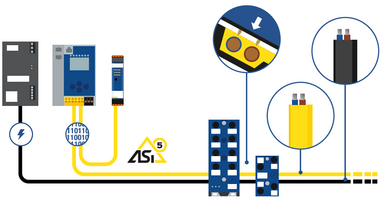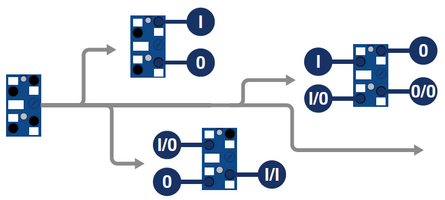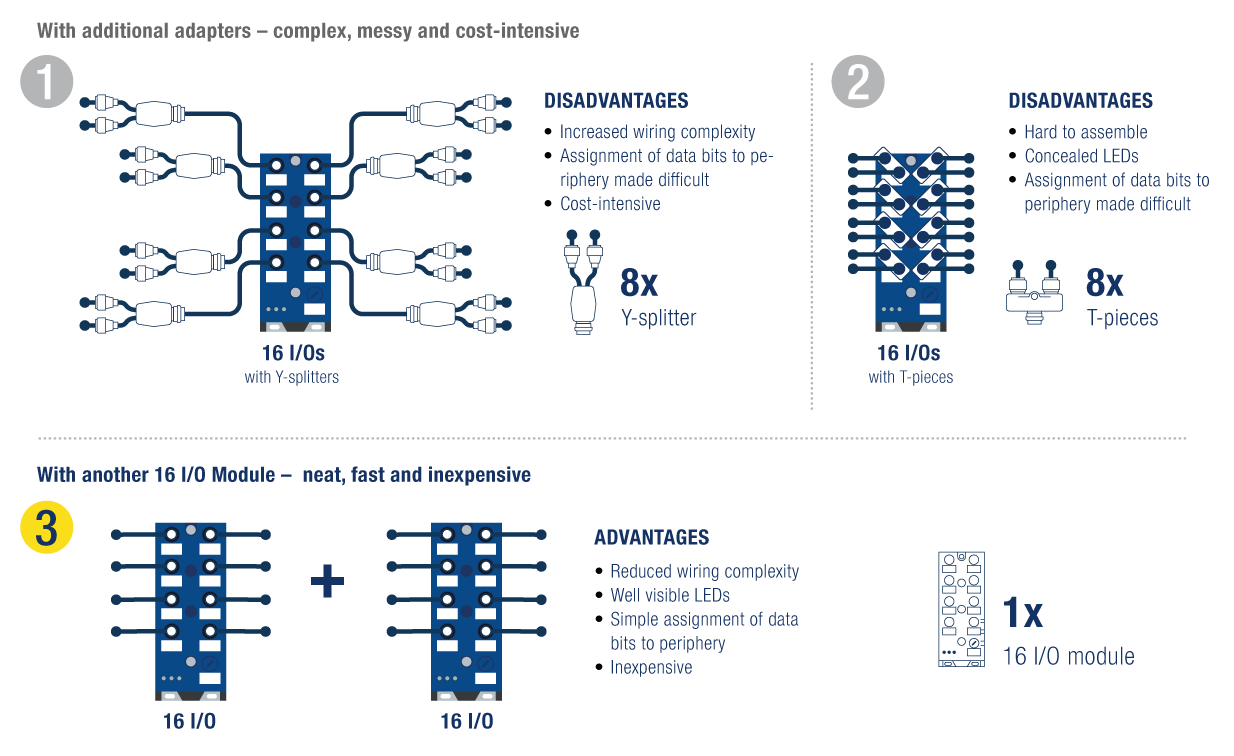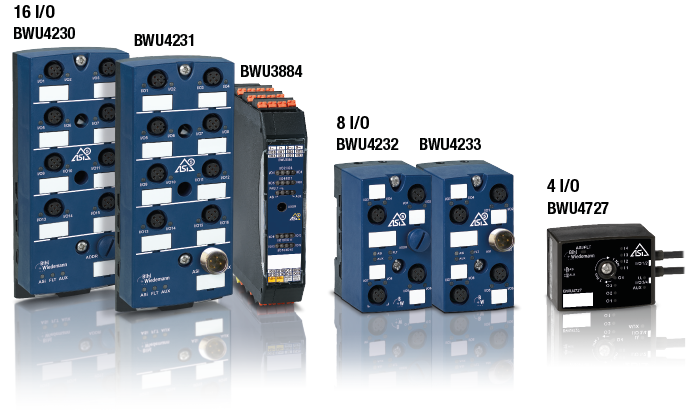Self-Configuring I/O Modules – Flexible, Cost-Effective, Simple Commissioning
What are Self-Configuring I/O Modules?
Self-configuring digital I/O modules are a new Bihl+Wiedemann product family. "Self-configuring" means: If you set an output bit in the PLC output data, it is an output with a diagnostic feedback in the corresponding input bit. If you do not set an output bit in the PLC output data, it is automatically mapped as an input signal in the PLC input data. This allows many different applications to be realized with the same module. The modules are especially also a great alternative to comparable Ethernet or IO-Link-based I/O solutions. You not only save on the module price but also on the wiring costs. You also benefit from channel-specific diagnostics.
For example, the new I/O technology with two signals per M12 allows you to conveniently realize the following applications:
- Drives with binary control: e.g., Lenze Smart Motor or SEW MOVI-SWITCH
- Sensors with one or two switching points: e.g., inductive proximity sensors
- Control panel elements: e.g., an illuminated pushbutton
We currently offer self-configuring modules with 4 I/Os, 8 I/Os and 16 I/Os, for which the ASi/AUX connection is established via profile cable, M12 connector or push-in terminal, depending on the product variant. Thanks to ASi-5, each of the 16-or 8-bit bidirectional process data is consistently transmitted in just 1.27 ms.
Content
- What are Self-Configuring I/O Modules?
- Advantages at a Glance
- Recommendation: Direct Peripheral Connection Instead of an Adapter
- ASi I/O technology in Comparison to IO-Link Hubs
- ASi I/O technology Compared to Ethernet I/O blocks
- Product family of the Self-Configuring I/O Modules
- FAQ about the Self-configuring I/O Modules
Cost-effective in Hardware and Wiring
- Modules are more inexpensive than comparable I/O solutions based on Ethernet or IO-Link
- Up to 70 % lower wiring costs compared to round cable solutions
- Reduced wiring complexity thanks to piercing technology and free choice of topology (e.g., ring, star) for energy and communication
- Cost-effective digital outputs
Flexible in Use
- Simplified spare parts management through one product for many applications
- Fields of application from motor control and signaling through to operating panels
- Many different applications can be realized with the same module
- For example, the 8 I/O module (BWU4232) is ideal for the Lenze Smart Motor, and the IP20 version (BWU3884) is great for control panels on the cabinet
- Short delivery times thanks to scaling effects and stable inventories
Recommendation: Direct Peripheral Connection Instead of an Adapter
You can decide flexibly from case to case how you want to connect the periphery to the self-configurable I/O module. However, the direct connection via standard M12 cable (connection cable or extension cable) is often the better alternative compared to the indirect connection via Y- or T-splitter. Here is a comparison of the three options for connecting 16 individual I/O signals:
ASi I/O technology in Comparison to IO-Link Hubs
To collect many I/O points in the field inexpensively, you do not need IO-Link. The IO-Link hubs are comparable in cost with the Bihl+Wiedemann I/O module, but you do not need an additional IO-Link master. You also benefit from the freedom of topology and wiring advantages of ASi. For fast switching operations, the transmission time should also not be ignored. Another advantage of the I/O modules: Each signal works bidirectionally with no need for configuration. In contrast, with the combination of IO-Link master and IO-Link hub, you always need an IODD to assign parameters. The maximum IO-Link cable length of 20 meters is also irrelevant here. That's because piercing technology enables you to distribute the digital I/Os anywhere along the ASi line with a length of up to 200 meters.
The piercing technology also significantly reduces the wiring complexity. Wiring costs are up to 70 % lower than with round cable solutions.
ASi I/O technology Compared to Ethernet I/O blocks
A single Ethernet I/O block is relatively expensive to purchase, its integration into the control system is complicated and the wiring complexity is quite high. Therefore, the "investment" does not usually justify the advantage of having up to 16 I/Os per block. In addition to that, the 16 I/O points are almost never at one position in the system. That is because of the long distances which have to be covered. In addition to the module wiring, several meters of cable lines to the periphery are added in a star configuration.
Our new I/O modules allow you to easily replace Ethernet I/O blocks. The cost-effective I/O modules are ideally suited for collecting the actual number of I/O points on-the-spot in the field. For this purpose, we offer a fine-grained portfolio with 4 I/Os up to 16 I/Os. Unused M12 ports are thus a thing of the past.
Another advantage: Our I/O modules allow you to easily integrate two ASi circuits with hundreds of I/O points into the control system. The complexity for this is only as high as for the integration of a single Ethernet I/O module.
The product family at a Glance
Bihl+Wiedemann already offers a number of product variants. However, we will continue expanding the product family of self-configuring I/O modules.
- Sensors and actuators can be connected in any combination; possibility of 2 signals per M12 connection
- Optional assignment of a fixed configuration possible for the ASi-5 modules using our software
- No M12 ports go unused thanks to a fine-grained portfolio ranging from 4 I/Os to 16 I/Os
- 16 inputs/outputs with ASi-5 in 1.27 ms
- Cost-effective and fast collection of many inputs and outputs
Bihl+Wiedemann's Choice Product with ASi-3 Technology
An "exception" in the product family is the self-configuring 4 I/O module (BWU4727), which is based on proven ASi-3 technology. The module in the active distributor housing is a cost-effective product variant for ASi-3 applications in which four I/Os are required.
- Depending on the application, it can be up to 4 digital inputs or up to 4 digital outputs.
- Reduced number of variants, because the module can be used instead of many previous ASi-3 digital modules.
- Sensor overload, output short circuits and missing AUX voltage are diagnosed as ASi-3 peripheral faults and indicated on the LED.
- Thanks to the ASi-3 A/B addressing, up to 62 modules can be connected to a single ASi circuit.
Connection technology
The new I/O technology is available in different product variants. The modules can be connected using the profile cable by means of the piercing technology. This is the most cost-effective and easy way of installation. Alternatively, the new I/O modules can also be connected to ASi via an external M12 connection. The IP20 variant (BWU3884) is perfect for use in the cabinet.
Self-configuring means that there is no need for signal parameterization. A connected sensor signal is automatically transmitted as digital input. If an output bit is set in the control system, the signal switches to "high". Optionally, the ASi-5 I/O modules can be manually configured. This way, each signal can be used individually as "input only" or "output only".
Since BWU4727 is an ASi-3 module, no channel-specific parameterization can be performed. If an output is set, the signal is an output; if the signal is read, it is an input.
ASi Cable
The yellow ASi cable represents the simplest connection technology and efficient power distribution. Discover how you can save around 68 % on wiring costs compared to round cable solutions.
AS-Interface
The standardized fieldbus system AS-Interface (ASi) helps you drastically reduce your wiring complexity. You also benefit from free choice of topology and cost-effective integration of safety features on the same infrastructure.
I/O modules are also available in the webshop
Discover our wide range of I/O modules, all compatible with the current ASi-3 or ASi-5 standard.








